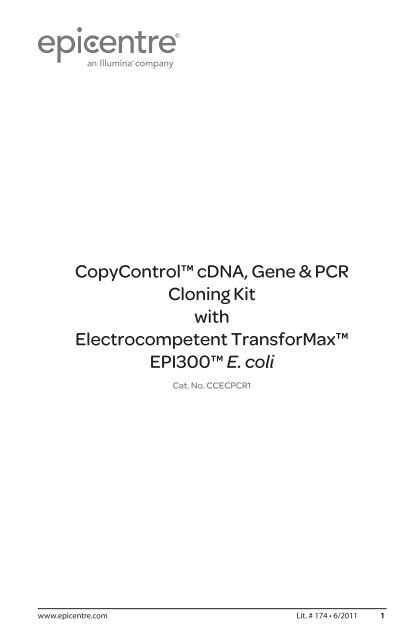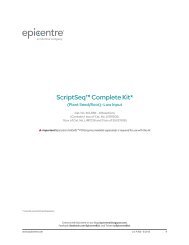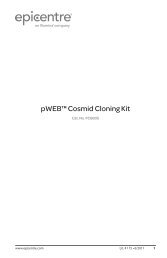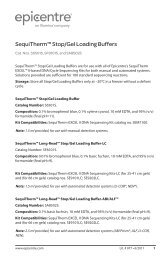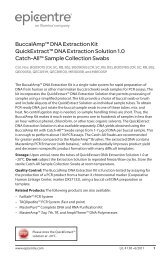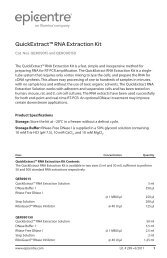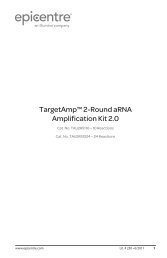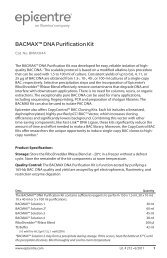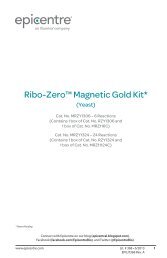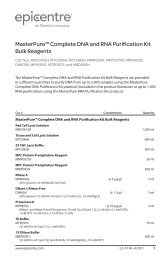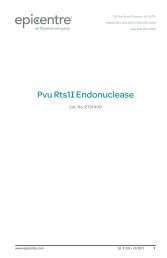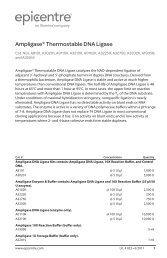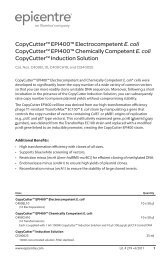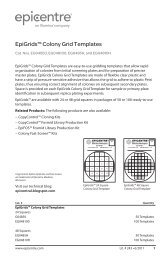Protocol for CopyControl⢠cDNA, Gene & PCR Cloning Kit with ...
Protocol for CopyControl⢠cDNA, Gene & PCR Cloning Kit with ...
Protocol for CopyControl⢠cDNA, Gene & PCR Cloning Kit with ...
You also want an ePaper? Increase the reach of your titles
YUMPU automatically turns print PDFs into web optimized ePapers that Google loves.
CopyControl <strong>cDNA</strong>, <strong>Gene</strong> & <strong>PCR</strong><br />
<strong>Cloning</strong> <strong>Kit</strong><br />
<strong>with</strong><br />
Electrocompetent Trans<strong>for</strong>Max<br />
EPI300 E. coli<br />
Cat. No. CCEC<strong>PCR</strong>1<br />
www.epicentre.com Lit. # 174 • 6/2011 1
CopyControl <strong>cDNA</strong>, <strong>Gene</strong> & <strong>PCR</strong> <strong>Cloning</strong> <strong>Kit</strong> <strong>with</strong><br />
Electrocompetent Trans<strong>for</strong>Max EPI300 E. coli<br />
Table of Contents<br />
1. Overview of the CopyControl <strong>Cloning</strong> System......................................................................... 3<br />
The CopyControl <strong>Cloning</strong> System Has Two Required Components................................... 3-4<br />
2. Materials..................................................................................................................................................... 5<br />
<strong>Kit</strong> contents................................................................................................................................................. 3<br />
CopyControl <strong>cDNA</strong>, <strong>Gene</strong> & <strong>PCR</strong> <strong>Cloning</strong> <strong>Kit</strong> <strong>with</strong> Electrocompetent<br />
Trans<strong>for</strong>Max EPI300 E. coli Contents................................................................................................ 5<br />
Additional Required Reagents............................................................................................................. 5<br />
Quality Control........................................................................................................................................... 5<br />
3. Overview of the CopyControl <strong>PCR</strong> <strong>Cloning</strong> Process............................................................... 6<br />
4. CopyControl <strong>PCR</strong> <strong>Cloning</strong> <strong>Protocol</strong>..........................................................................................7-11<br />
<strong>Gene</strong>ral Considerations.......................................................................................................................... 7<br />
Precipitation of the <strong>PCR</strong> Product......................................................................................................... 7<br />
End-Repair to <strong>Gene</strong>rate Blunt-Ended and 5′-Phosphorylated <strong>PCR</strong> Product....................... 8<br />
Ligation of End-Repaired <strong>PCR</strong> Product into CopyControl<br />
pCC1 (Blunt <strong>Cloning</strong>-Ready) Vector................................................................................................ 8<br />
Trans<strong>for</strong>mation of the Electrocompetent Trans<strong>for</strong>Max EPI300 E. coli.................................... 9<br />
Selecting, Screening and Amplifying the CopyControl <strong>PCR</strong> Clones Grown at<br />
Single-Copy Number......................................................................................................................... 10-12<br />
Plating and Selecting the CopyControl <strong>PCR</strong> Clones at Single-Copy Number...................10<br />
Size Screening the CopyControl <strong>PCR</strong> Clones Grown at Single-Copy Number..................10<br />
Inducing the CopyControl <strong>PCR</strong> Clones, Grown at Single-Copy Number, to<br />
High-Copy Number.............................................................................................................................11<br />
5. Appendix A<br />
<strong>Cloning</strong> the Control <strong>PCR</strong> Product......................................................................................................12<br />
6. Appendix B<br />
pCC1 (Blunt <strong>Cloning</strong>-Ready) Vector and Sequencing Primers Data.............................. 13-15<br />
7. References................................................................................................................................................15<br />
2 www.epicentre.com
Overview of the CopyControl <strong>Cloning</strong> System<br />
CopyControl <strong>cDNA</strong>, <strong>Gene</strong> & <strong>PCR</strong> <strong>Cloning</strong> <strong>Kit</strong> <strong>with</strong><br />
Electrocompetent Trans<strong>for</strong>Max EPI300 E. coli<br />
The CopyControl <strong>Cloning</strong> System,* based on technology developed by Dr. Waclaw<br />
Szybalski 1-3 at the University of Wisconsin-Madison, combines the clone stability<br />
af<strong>for</strong>ded by single-copy cloning <strong>with</strong> the advantages of high yields of DNA obtained by<br />
“on-demand” induction of the clones to high-copy number. For example, CopyControl<br />
BAC (Bacterial Artificial Chromosome) clones can be induced to 10-20 copies per cell<br />
and CopyControl Fosmid and <strong>PCR</strong> clones can be induced from single copy to 10-200<br />
copies per cell to improve DNA yields <strong>for</strong> sequencing, fingerprinting, subcloning, in vitro<br />
transcription, and other applications. CopyControl <strong>Cloning</strong> <strong>Kit</strong>s <strong>for</strong> BAC cloning, fosmid<br />
library production, and <strong>cDNA</strong>, <strong>Gene</strong> & <strong>PCR</strong> cloning are available.<br />
The CopyControl <strong>Cloning</strong> System Has Two Required Components<br />
1. The CopyControl pCC1 (Blunt <strong>Cloning</strong>-Ready) Vector contains both the E. coli<br />
F factor single-copy origin of replication and the high-copy oriV origin of replication.<br />
2. Initiation of replication from oriV requires the trfA gene product that is supplied<br />
by the Trans<strong>for</strong>Max EPI300 E. coli cells.* The cells have been engineered so that a<br />
mutant trfA gene is under tight control of an inducible promoter. In the absence<br />
of the induction agent (a simple sugar), trfA gene expression is repressed and the<br />
clones are maintained at single-copy number in the EPI300 cells. Addition of the<br />
CopyControl Fosmid AutoInduction Solution induces expression of the trfA gene<br />
resulting in amplification of the clone to high-copy number.<br />
Features of the CopyControl pCC1 (Blunt <strong>Cloning</strong>-Ready) Vector (Fig. 1):<br />
• Chloramphenicol resistance as an antibiotic selectable marker.<br />
• E. coli F factor-based partitioning and single-copy origin of replication.<br />
• oriV high-copy origin of replication.<br />
• Bacteriophage lambda cos site <strong>for</strong> lambda packaging or lambda-terminase cleavage.<br />
• Bacteriophage P1 loxP site <strong>for</strong> Cre-recombinase cleavage.<br />
• Bacteriophage T7 RNA polymerase promoter flanking the cloning site.<br />
• Suitable <strong>for</strong> “blue/white” screening.<br />
techhelp@epicentre.com • (800) 284-8474 3
CopyControl <strong>cDNA</strong>, <strong>Gene</strong> & <strong>PCR</strong> <strong>Cloning</strong> <strong>Kit</strong> <strong>with</strong><br />
Electrocompetent Trans<strong>for</strong>Max EPI300 E. coli<br />
Eco72 I 361<br />
Apa I 6973<br />
Bsa I 6811<br />
Hpa I 7630<br />
Pci I 7483<br />
parC<br />
1 FP T7<br />
RP<br />
Sca I 805<br />
cos loxP<br />
lacZ<br />
SnaB I 5632<br />
BstX I 5086<br />
Chl R<br />
CopyControl<br />
parB<br />
pCC1 Blunt redF<br />
<strong>Cloning</strong>-Ready<br />
Vector<br />
8139 bp oriV<br />
parA<br />
ori2<br />
Afe I 4567<br />
repE<br />
EcoN I 3470<br />
BstZ17 I 1844<br />
Sac II 2483<br />
Note: Not all restriction enzymes that cut only once are indicated above.<br />
See Appendix B <strong>for</strong> complete restriction in<strong>for</strong>mation.<br />
Primers are not drawn to scale.<br />
FP<br />
230-256<br />
T7<br />
311-330<br />
Eco72 I<br />
361<br />
RP<br />
476-501<br />
200<br />
250 300<br />
350 400<br />
450 500<br />
FP = pCC1/pEpiFOS Foward Sequencing Primer<br />
RP = pCC1/pEpiFOS Reverse Sequencing Primer<br />
T7 = T7 Promoter Primer<br />
5' GGATGTGCTGCAAGGCGATTAAGTTGG 3'<br />
5' CTCGTATGTTGTGTGGAATTGTGAGC 3'<br />
5' TAATACGACTCACTATAGGG 3'<br />
Figure 1. pCC1 (Blunt <strong>Cloning</strong>-Ready) Vector Map.<br />
*see page 15 <strong>for</strong> licensing in<strong>for</strong>mation.<br />
4 www.epicentre.com
2. Materials<br />
<strong>Kit</strong> Contents<br />
CopyControl <strong>cDNA</strong>, <strong>Gene</strong> & <strong>PCR</strong> <strong>Cloning</strong> <strong>Kit</strong> <strong>with</strong><br />
Electrocompetent Trans<strong>for</strong>Max EPI300 E. coli<br />
Desc. Concentration Quantity<br />
CopyControl <strong>cDNA</strong>, <strong>Gene</strong> & <strong>PCR</strong> <strong>Cloning</strong> <strong>Kit</strong> <strong>with</strong> Electrocompetent Trans<strong>for</strong>Max EPI300 E. coli<br />
Contents<br />
Reagents included in the kit are sufficient to clone 20 <strong>PCR</strong> products.<br />
CopyControl pCC1 (Blunt <strong>Cloning</strong>-Ready) Vector (75 ng/μl) 20 μl<br />
(linearized at the unique Eco72 I site and dephosphorylated)<br />
<strong>PCR</strong> Precipitation Solution<br />
1 ml<br />
<strong>PCR</strong> 10X <strong>Cloning</strong> Buffer<br />
50 μl<br />
<strong>PCR</strong> End-Repair Enzyme Mix<br />
25 μl<br />
Fast-Link DNA Ligase (50 U @ 2 U/μl) 25 μl<br />
EpiBlue Solution<br />
2.5 ml<br />
EpiLyse Solution<br />
10 ml<br />
Control <strong>PCR</strong> Product (4 ng/μl, 1,360 bp) 20 μl<br />
Supercoiled DNA Marker (10 ng/μl, ~8.1 Kb) 200 μl<br />
Sterile Water<br />
500 μl<br />
Electrocompetent Trans<strong>for</strong>Max EPI300 E. coli<br />
10 x 100 μl<br />
[F – mcrA ∆(mrr-hsdRMS-mcrBC) (Str R ) φ80dlacZ∆M15 ∆lacX74 recA1 endA1 araD139 ∆(ara, leu)7697 galU galK<br />
λ – rpsL nupG trfA dhfr]<br />
CopyControl Fosmid AutoInduction Solution (500X concentrate) 4 x 1 ml<br />
Note: EpiBlue and EpiLyse Solutions are supplied together in a poly bag. Trans<strong>for</strong>Max EPI300<br />
cells and 1 ml of the CopyControl Fosmid AutoInduction Solution are supplied together in<br />
their own box.<br />
Storage: Store the Electrocompetent Trans<strong>for</strong>Max EPI300 E. coli at –70°C. Store the<br />
EpiBlue and EpiLyse Solutions at room temperature. Store the remainder of the kit<br />
components at –20°C.<br />
Additional Required Reagents<br />
In addition to the components supplied, the following reagents are required:<br />
LB plates (1% Tryptone, 0.5% Yeast Extract, 1% NaCl, 15 g/L agar, [pH 7.0]) + 12.5 μg/ml<br />
chloramphenicol and (optional components) X-Gal (40 μg/ml) and IPTG (0.4 mM)<br />
TE Buffer (10 mM Tris-HCl [pH 7.5], 1 mM EDTA)<br />
Supercoiled DNA Molecular Weight Markers (>8 Kb)<br />
Quality Control<br />
The CopyControl <strong>cDNA</strong>, <strong>Gene</strong> & <strong>PCR</strong> <strong>Cloning</strong> <strong>Kit</strong> <strong>with</strong> Electrocompetent Trans<strong>for</strong>Max<br />
EPI300 E. coli cells is function-tested using the Control <strong>PCR</strong> Product provided. Greater<br />
than 1 x 10 6 white or light blue colonies are obtained per microgram of the Control <strong>PCR</strong><br />
Product when using Electrocompetent Trans<strong>for</strong>Max EPI300 cells. At least 70% of all white<br />
colonies must contain the correct size insert.<br />
techhelp@epicentre.com • (800) 284-8474 5
CopyControl <strong>cDNA</strong>, <strong>Gene</strong> & <strong>PCR</strong> <strong>Cloning</strong> <strong>Kit</strong> <strong>with</strong><br />
Electrocompetent Trans<strong>for</strong>Max EPI300 E. coli<br />
3. Overview of the CopyControl <strong>PCR</strong> <strong>Cloning</strong> Process<br />
The CopyControl <strong>cDNA</strong>, <strong>Gene</strong> & <strong>PCR</strong> <strong>Cloning</strong> <strong>Kit</strong> can be used to clone 20 <strong>PCR</strong> products,<br />
RT-<strong>PCR</strong> products, restriction fragments, or <strong>cDNA</strong>s. The entire process, including cloning,<br />
selecting, and screening of the clones can be completed in less than 24 hours.<br />
In the CopyControl <strong>PCR</strong> cloning process, clones are selected and grown at single-copy<br />
number to ensure the stability of the insert and viability of the clone. This is crucial if the<br />
<strong>PCR</strong> product may be unstable (e.g., contains repetitive sequences, high GC or AT content)<br />
or encodes a product that may be lethal or detrimental to the host cell. Then, clones<br />
are grown in culture and induced to high-copy number by adding of the CopyControl<br />
Fosmid AutoInduction Solution.<br />
CopyControl Fosmid AutoInduction Solution, which replaces the standard CopyControl<br />
Induction Solution, was developed <strong>for</strong> induction of the copy number of CopyControl<br />
single-copy plasmid and fosmid DNA to 200 and 50 copies respectively. The new<br />
protocol is simple and requires addition of the Autoinduction Solution to the culture<br />
medium prior to inoculation of the culture, bypassing hands-on subculturing steps. The<br />
autoinduction process can be per<strong>for</strong>med in any culture volume based on your needs.<br />
<strong>Gene</strong>rally, 200 μl to 1 ml of culture will provide sufficient DNA <strong>for</strong> most applications. We<br />
provide a procedure <strong>for</strong> amplifying clones from 200-μl to 50-ml cultures on page 11.<br />
An overview of the steps involved in using the CopyControl <strong>cDNA</strong>, <strong>Gene</strong> & <strong>PCR</strong> <strong>Cloning</strong><br />
<strong>Kit</strong> is presented below.<br />
<strong>PCR</strong> amplify the DNA sequence to be cloned.<br />
Precipitate the <strong>PCR</strong> product using the <strong>PCR</strong> Precipitation Solution (Step A).<br />
End-repair the <strong>PCR</strong> product to blunt-ended, 5'-phosphorylated DNA (Step B).<br />
Ligate the end-repaired <strong>PCR</strong> product into the pCC1 (Blunt-<strong>Cloning</strong> Ready) Vector (Step C).<br />
Trans<strong>for</strong>m the Electrocompetent Trans<strong>for</strong>Max EPI300 E. coli (Step D).<br />
Plate cells and select overnight at single-copy number (Step E).<br />
Size screen the clones grown at single-copy number (Step E).<br />
Induce the clones from single-copy number to high-copy number (Step E).<br />
6 www.epicentre.com
4. CopyControl <strong>PCR</strong> <strong>Cloning</strong> <strong>Protocol</strong><br />
<strong>Gene</strong>ral Considerations<br />
CopyControl <strong>cDNA</strong>, <strong>Gene</strong> & <strong>PCR</strong> <strong>Cloning</strong> <strong>Kit</strong> <strong>with</strong><br />
Electrocompetent Trans<strong>for</strong>Max EPI300 E. coli<br />
1. <strong>PCR</strong> products up to 15 kb, produced using any thermostable DNA polymerase(s),<br />
including Taq, proofreading polymerases, and enzyme blends, can be efficiently<br />
cloned <strong>with</strong>out the need <strong>for</strong> gel or column purification. Although it is not necessary,<br />
if you wish to gel-purify the <strong>PCR</strong> product prior to cloning, it is extremely important to<br />
avoid damage of DNA due to exposure to UV light. Even exposure <strong>for</strong> short periods<br />
of time can decrease the efficiency of cloning by two orders of magnitude or more.<br />
2. The CopyControl pCC1 (Blunt <strong>Cloning</strong>-Ready) Vector supplied in the kit has been<br />
linearized, dephosphorylated, extensively purified, and is ready to use in the ligation<br />
step.<br />
A. Precipitation of the <strong>PCR</strong> Product<br />
<strong>Kit</strong> component used in this step: <strong>PCR</strong> Precipitation Solution.<br />
Use the procedure described in Steps A1-A5 to purify <strong>PCR</strong> products >500 bp. However,<br />
the recovery of <strong>PCR</strong> products less than 500 bp is not efficient using this method.<br />
There<strong>for</strong>e, we recommend that <strong>PCR</strong> products of 500 bp, add an equal volume of <strong>PCR</strong><br />
Precipitation Solution. Vortex vigorously to mix. If the concentration of the <strong>PCR</strong><br />
product is expected to be >10 ng/μl, proceed to centrifugation (Part A, Step 2)<br />
immediately. If the concentration of the <strong>PCR</strong> product is expected to be ≤10 ng/μl,<br />
incubate the mixture on ice <strong>for</strong> 30 minutes be<strong>for</strong>e centrifugation to maximize<br />
recovery.<br />
2. Centrifuge <strong>for</strong> 5 minutes at 12,500 rpm at 4°C.<br />
Important: Centrifugation at 4°C is required to obtain maximum recovery of the <strong>PCR</strong><br />
product.<br />
3. Carefully aspirate and discard all the supernatant <strong>with</strong>out disrupting the DNA<br />
pellet. Do not pour out the supernatant. The DNA pellet will not be visible. Since it is<br />
important to get rid of all the supernatant, centrifuge again briefly if necessary.<br />
4. Resuspend the pellet in 15 μl of TE buffer if the starting <strong>PCR</strong> product concentration<br />
is ≤ 25 ng/μl. Resuspend the pellet in 25 μl of TE buffer if the starting <strong>PCR</strong> product<br />
concentration is > 25 ng/μl.<br />
5. Measure DNA concentration using a fluorometer, if available.<br />
Note: A spectrophotometer may not provide an accurate DNA concentration, which is<br />
important <strong>for</strong> a successful ligation reaction to achieve the highest cloning efficiency.<br />
techhelp@epicentre.com • (800) 284-8474 7
CopyControl <strong>cDNA</strong>, <strong>Gene</strong> & <strong>PCR</strong> <strong>Cloning</strong> <strong>Kit</strong> <strong>with</strong><br />
Electrocompetent Trans<strong>for</strong>Max EPI300 E. coli<br />
B. End-Repair to <strong>Gene</strong>rate Blunt-Ended and 5′-Phosphorylated <strong>PCR</strong> Product<br />
<strong>Kit</strong> components used in this step: <strong>PCR</strong> 10X <strong>Cloning</strong> Buffer, <strong>PCR</strong> End-Repair Enzyme<br />
Mix and Sterile Water.<br />
*Note: In the reaction, 0.014 pmol of <strong>PCR</strong> product will provide the recommended vector to<br />
insert ratio of 1:1. One can calculate the amount (ng) of <strong>PCR</strong> product needed in each reaction<br />
as follows:<br />
75 ng (amount of pCC1 vector in the ligation) x Length of <strong>PCR</strong> product (in bp)<br />
ng of <strong>PCR</strong> product =<br />
8,139 (size in bp of the CopyControl pCC1 vector)<br />
1. Thaw and thoroughly mix all of the reagents. Set up the following reaction:<br />
x μl sterile water<br />
1 μl <strong>PCR</strong> 10X <strong>Cloning</strong> Buffer<br />
x μl <strong>PCR</strong> product (0.014 pmol)* from Step A<br />
1 μl <strong>PCR</strong> End-Repair Enzyme Mix<br />
10 μl Total reaction volume<br />
2. Mix by vortexing or flicking the bottom of the tube. Centrifuge briefly to collect all<br />
solution in the bottom of the tube. Incubate the reaction at room temperature <strong>for</strong><br />
30 minutes.<br />
3. Heat the reaction at 70°C <strong>for</strong> 10 minutes to inactivate the enzymes in the <strong>PCR</strong><br />
End-Repair Enzyme Mix.<br />
Important: Complete heat inactivation of the enzymes is crucial to avoid background<br />
clones caused by vector self-ligation.<br />
4. Cool the reaction on ice <strong>for</strong> 3-5 minutes. Proceed to Part C.<br />
C. Ligation of End-Repaired <strong>PCR</strong> Product into CopyControl pCC1 (Blunt <strong>Cloning</strong>-<br />
Ready) Vector<br />
<strong>Kit</strong> components used in this step: Fast-Link DNA Ligase and CopyControl pCC1 (Blunt<br />
<strong>Cloning</strong>-Ready) Vector.<br />
1. To the 10 μl end-repair reaction from Part B, add 1 μl of the CopyControl pCC1 (Blunt<br />
<strong>Cloning</strong>-Ready) Vector and 1 μl of Fast-Link DNA Ligase.<br />
2. Mix by vortexing or by flicking the bottom of the tube. Centrifuge the tube briefly to<br />
collect all of the solution in the bottom.<br />
3. Incubate the reaction at room temperature <strong>for</strong> 1 hour.<br />
Note: Longer incubation times, up to 2 hours, may increase the total number of clones.<br />
However, it is not necessary in most cases because more than enough clones <strong>with</strong> the<br />
desired <strong>PCR</strong> product will be generated under standard reaction conditions.<br />
4. Heat the reaction at 70°C <strong>for</strong> 10 minutes to inactivate the Fast-Link DNA Ligase.<br />
Important: Complete heat-inactivation of the enzyme will ensure the highest cloning<br />
efficiency.<br />
5. Cool the reaction on ice <strong>for</strong> 3-5 minutes.<br />
8 www.epicentre.com
CopyControl <strong>cDNA</strong>, <strong>Gene</strong> & <strong>PCR</strong> <strong>Cloning</strong> <strong>Kit</strong> <strong>with</strong><br />
Electrocompetent Trans<strong>for</strong>Max EPI300 E. coli<br />
D. Trans<strong>for</strong>mation of the Electrocompetent Trans<strong>for</strong>Max EPI300 E. coli<br />
<strong>Kit</strong> components used in this step: Electrocompetent Trans<strong>for</strong>Max EPI300 E. coli.<br />
Reagents supplied by the user: SOC or LB Medium.<br />
1. Prepare 1 ml of SOC or LB medium (do not include antibiotic in the medium)<br />
<strong>for</strong> each electroporation to be per<strong>for</strong>med. This medium will be used <strong>for</strong> postelectroporation<br />
outgrowth of trans<strong>for</strong>med cells. Maintain the medium at room<br />
temperature.<br />
2. Prechill electroporation cuvettes and 1.5-ml tubes on ice.<br />
3. Set up the electroporation device according to the manufacturer’s recommendations<br />
<strong>for</strong> bacterial (E. coli) electroporation.<br />
4. Thaw Trans<strong>for</strong>Max EPI300 Electrocompetent E. coli cells on ice. Mix gently. Use the<br />
cells immediately. Unused cells can be refrozen at –70°C.<br />
Note: Refrozen cells may have reduced trans<strong>for</strong>mation efficiency but in most cases, the<br />
reduction is not significant enough to interfere <strong>with</strong> the desired results.<br />
5. Mix 1 μl of the Ligation Reaction from Part C <strong>with</strong> 50 μl of the electrocompetent cells,<br />
and vortex gently to mix.<br />
6. Transfer the cell/ligation mixture into a prechilled electroporation cuvette. Wipe any<br />
condensation off the cuvette.<br />
7. Mix 1 μl of the Ligation Reaction from Part C <strong>with</strong> 50 μl of the electrocompetent cells,<br />
vortex gently to mix well.<br />
Note: Arcing during electroporation is rare and is usually due to high salt concentration<br />
in the reaction. If arcing occurs, repeat electroporation by mixing 0.8 μl of the ligation<br />
reaction <strong>with</strong> 50 μl of the competent cells, and use a new prechilled cuvette.<br />
8. Apply the electric pulse at manufacturer’s recommendations <strong>for</strong> bacterial (E. coli)<br />
electroporation.<br />
Note: Arcing during electroporation is rare and is usually due to high salt concentration<br />
in the reaction. If arcing occurs, repeat electroporation by mixing 0.8 μl of the ligation<br />
reaction <strong>with</strong> 50 μl of the competent cells, and use a new prechilled cuvette.<br />
9. Immediately after electroporation, add 950 μl of room temperature SOC or LB<br />
medium to the cuvette. Mix gently by pipetting two to three times.<br />
10. Transfer the cells to a 15-ml tube and incubate at 37°C <strong>with</strong> shaking at 220-230 rpm<br />
<strong>for</strong> 1 hour to allow the cells to recover and the antibiotic resistance gene to be<br />
expressed.<br />
techhelp@epicentre.com • (800) 284-8474 9
CopyControl <strong>cDNA</strong>, <strong>Gene</strong> & <strong>PCR</strong> <strong>Cloning</strong> <strong>Kit</strong> <strong>with</strong><br />
Electrocompetent Trans<strong>for</strong>Max EPI300 E. coli<br />
E. Selecting, Screening and Amplifying the CopyControl <strong>PCR</strong> Clones Grown at<br />
Single-Copy Number<br />
<strong>Kit</strong> components used in this step: EpiLyse Solution, EpiBlue Solution, Supercoiled<br />
DNA Size Marker and CopyControl Fosmid AutoInduction Solution.<br />
Reagents supplied by the user: LB Medium + chloramphenicol (12.5 μg/ml) and<br />
Supercoiled DNA Size Markers (>8 Kb).<br />
Blue/white screening of the clones is not necessary because of the very low number of<br />
blue (nonrecombinant) clones that will be obtained. However, if blue/white screening is<br />
desired, include X-Gal (40 μg/ml) and IPTG (0.4 mM) in the plates.<br />
Plating and Selecting the CopyControl <strong>PCR</strong> Clones at Single-Copy Number.<br />
1. Prepare and prewarm to 37°C three LB plates containing chloramphenicol<br />
(12.5 μg/ml) (and X-Gal and IPTG if desired). Prepare 100 μl each of a 1:10 and a 1:100<br />
dilution of the trans<strong>for</strong>med cell culture from Part D in SOC or LB medium. Spread 100<br />
μl of undiluted cell culture, and the 1:10 and 1:100 dilutions, individually onto the<br />
plates.<br />
Note: Although it is not required to plate all three concentrations of cells, doing so<br />
increase the chances of obtaining a sufficient number of evenly spread out colonies.<br />
2. Grow the plates overnight at 37°C. We recommend incubating the plates <strong>for</strong> at least<br />
20 hours.<br />
Note: If X-Gal and IPTG have been included in the plates <strong>for</strong> blue/white screening, some<br />
white colonies (recombinant clones) may develop a light blue center if grown to larger<br />
sizes or during extended storage at 4°C. This phenomenon is likely due to the production<br />
of a small amount of functional LacZ α-peptide that can result when cloning relatively<br />
small DNAs. Most of these light blue clones will contain the desired <strong>PCR</strong> product<br />
Size-Screening the CopyControl <strong>PCR</strong> Clones Grown at Single-Copy Number.<br />
3. Add 300 μl of LB medium + chloramphenicol (12.5 μg/ml) to each of ten 1.5-ml<br />
microcentrifuge tubes.<br />
4. Randomly pick 10 colonies (white or light blue colonies if blue/white screening was<br />
done) <strong>with</strong> sterile pipette tips and transfer them individually into the 1.5-ml tubes.<br />
Note: If the colony size is ≤1 mm diameter, pick the whole colony; if the size is >1 mm<br />
diameter, only pick a small amount of the cells, because too much cell material may<br />
interfere <strong>with</strong> the screening process.<br />
5. Incubate at 37°C <strong>for</strong> 30 minutes <strong>with</strong> vigorous shaking.<br />
Important: Vigorous shaking is crucial! For example, tape the tubes horizontally to the<br />
shaker. Placing the tubes in a rack and taping the rack to the bottom of the shaker is not<br />
sufficient.<br />
10 www.epicentre.com
CopyControl <strong>cDNA</strong>, <strong>Gene</strong> & <strong>PCR</strong> <strong>Cloning</strong> <strong>Kit</strong> <strong>with</strong><br />
Electrocompetent Trans<strong>for</strong>Max EPI300 E. coli<br />
6. Transfer 100 μl of the cell cultures into separate 1.5-ml microcentrifuge tubes and<br />
store them at 4°C. These aliquots will be used as inocula <strong>for</strong> the clone amplification<br />
process in Part E, Step 12. Do not add CopyControl Fosmid AutoInduction Solution to<br />
these tubes.<br />
7. Centrifuge the remaining 200 μl of cell cultures <strong>for</strong> 1 minute at >10,000 x g.<br />
8. Discard the supernatant. Resuspend the cell pellets in 20 μl (10-50 μl can be used)<br />
of the EpiBlue Solution. Vortex to completely resuspend the cells. It is critical to<br />
completely resuspend the cell pellets to maximize the amount of DNA released from<br />
the cells.<br />
9. Add an equal volume of the EpiLyse Solution and vortex vigorously. Load 10-15 μl<br />
of the lysed cell solutions on a 1% agarose gel. If the lysed cell solutions are too<br />
viscous to load onto a gel, add more EpiLyse Solution until loading is manageable. It<br />
is important to make sure the lysed cell solution stays in the wells since the viscous<br />
solution may be easily pulled out of the wells when retracting the pipette tips. The<br />
remaining lysed cell solutions can be stored at room temperature <strong>for</strong> up to 1 week in<br />
the event additional gels are run.<br />
Note: If a cleaner gel is desired (e.g., less RNA in the gel), the lysed cell solutions can be<br />
incubated at 70°C <strong>for</strong> 15 minutes be<strong>for</strong>e loading onto a gel.<br />
10. Load 10 μl of the Supercoiled DNA Size Marker and other supercoiled DNA markers,<br />
if available (not supplied in the kit), to lanes of the gel adjacent to the lysed cell<br />
extracts. Run the gel <strong>for</strong> 45-60 minutes. Stain <strong>with</strong> a 1:10,000 dilution of SYBR® Gold<br />
in gel-running buffer or water, or prolonged staining <strong>with</strong> ethidium bromide.<br />
11. The Supercoiled DNA Size Marker is ~8.1 Kb, the same size as the CopyControl pCC1<br />
<strong>Cloning</strong> Vector. There<strong>for</strong>e, the clones containing the <strong>PCR</strong> product will migrate at a<br />
size equal to 8.1 kb + the size of the cloned <strong>PCR</strong> product. Once the desired clones are<br />
identified, be sure to prepare a glycerol stock of each <strong>for</strong> long-term storage.<br />
Inducing the CopyControl <strong>PCR</strong> Clones, Grown at Single-Copy Number, to High-Copy<br />
Number.<br />
The autoinduction process can be per<strong>for</strong>med in any culture volume based on your needs.<br />
<strong>Gene</strong>rally, 200 μl to 1 ml of culture will provide sufficient DNA <strong>for</strong> most applications. In<br />
this step, we provide the procedure <strong>for</strong> amplifying the clones in 200-μl to 50-ml cultures.<br />
12. Once the desired clones are identified, use the 100 μl of uninduced cell cultures<br />
stored at 4°C from Part E, Step 6 (page 10), to start overnight cultures as needed.<br />
Alternatively, choose the desired clones directly from the overnight trans<strong>for</strong>mation<br />
plate.<br />
13. Choose the preparation size and vessel to be used from the table below prior to<br />
inoculation of the culture. Supplement the appropriate amount of LB medium + 12.5 μg/<br />
ml chloramphenicol <strong>with</strong> the 500X CopyControl Fosmid AutoInduction Solution.<br />
techhelp@epicentre.com • (800) 284-8474 11
CopyControl <strong>cDNA</strong>, <strong>Gene</strong> & <strong>PCR</strong> <strong>Cloning</strong> <strong>Kit</strong> <strong>with</strong><br />
Electrocompetent Trans<strong>for</strong>Max EPI300 E. coli<br />
Volume of Starting Culture<br />
(LB + Chloramphenicol<br />
[12.5 μg/ml])<br />
* Mix thoroughly after thawing.<br />
Volume of 500X<br />
CopyControl Fosmid<br />
AutoInduction Solution*<br />
Size of Vessel to be<br />
Used<br />
200 μl 0.4 μl 1-ml 96-well plate<br />
1 ml 2 μl<br />
2.2-ml deep-well<br />
96-well plate<br />
2 ml 4 μl 14-ml Falcon tube<br />
5 ml 10 μl 14-ml Falcon tube<br />
50 ml 100 μl 250-ml Erlenmeyer flask<br />
14. Inoculate the medium <strong>with</strong> a small portion of the desired CopyControl clones from<br />
an overnight plate.<br />
15. Incubate the culture overnight (16-20 hours) at 37°C <strong>with</strong> vigorous shaking.<br />
Important: Vigorous shaking is crucial <strong>for</strong> proper aeration! Cultures incubated <strong>for</strong> longer<br />
or shorter periods of time may not properly induce.<br />
16. Collect the cells by centrifugation and purify the DNA. For 1-ml cultures, use the<br />
BACMAX96 DNA Purification <strong>Kit</strong> (Epicentre); <strong>for</strong> 2-ml, 5-ml, and 50-ml cultures,<br />
use the FosmidMAX DNA Purification <strong>Kit</strong> (<strong>with</strong> consumable plactics) (Epicentre).<br />
Alternatively, standard laboratory methods <strong>for</strong> DNA purification can be used.<br />
5. Appendix A<br />
<strong>Cloning</strong> the Control <strong>PCR</strong> Product<br />
The 1,360-bp Control <strong>PCR</strong> Product is supplied to test the cloning efficiency of the kit.<br />
1. End-repair the Control <strong>PCR</strong> Product to generate blunt-ended and 5′-phosphorylated<br />
DNA. Thaw and thoroughly mix all of the reagents. Set up the following reaction:<br />
5 μl sterile water<br />
1 μl <strong>PCR</strong> 10X <strong>Cloning</strong> Buffer<br />
3 μl Control <strong>PCR</strong> Product<br />
1 μl <strong>PCR</strong> End-Repair Enzyme Mix<br />
10 μl Total reaction volume<br />
2. Mix by vortexing or flicking the bottom of the tube. Centrifuge briefly to collect all<br />
the solution in the bottom of the tube. Incubate the reaction at room temperature <strong>for</strong><br />
30 minutes.<br />
3. Heat the reaction at 70°C <strong>for</strong> 10 minutes to inactivate the <strong>PCR</strong> End-Repair enzymes.<br />
4. Cool the reaction on ice <strong>for</strong> 3-5 minutes.<br />
5. Ligate the blunt-ended, 5′-phosphorylated Control <strong>PCR</strong> product into the CopyControl<br />
pCC1 (Blunt <strong>Cloning</strong>-Ready) Vector, trans<strong>for</strong>m the Electrocompetent Trans<strong>for</strong>Max<br />
12 www.epicentre.com
CopyControl <strong>cDNA</strong>, <strong>Gene</strong> & <strong>PCR</strong> <strong>Cloning</strong> <strong>Kit</strong> <strong>with</strong><br />
Electrocompetent Trans<strong>for</strong>Max EPI300 E. coli<br />
EPI300 E. coli, and plate as described in Parts C and D. Then, select and size screen the<br />
clones, and induce them to high-copy number according to the procedure in Part E.<br />
Greater than 70% of the white colonies will have the correct control <strong>PCR</strong> product,<br />
<strong>with</strong> a size of ~9.5 kb, including the vector.<br />
6. Appendix B<br />
pCC1 (Blunt <strong>Cloning</strong>-Ready) Vector and Sequencing Primers Data<br />
pCC1/pEpiFOS-5 Sequencing Primers<br />
Primers are available separately:<br />
pCC1/pEpiFOS Forward Sequencing Primer<br />
Cat. No. F5FP010<br />
5′ GGATGTGCTGCAAGGCGATTAAGTTGG 3′ 1 nmol supplied in TE Buffer at 50 μM<br />
pCC1/pEpiFOS Reverse Sequencing Primer<br />
Cat. No. F5RP011<br />
5′ CTCGTATGTTGTGTGGAATTGTGAGC 3′ 1 nmol supplied in TE Buffer at 50 μM<br />
Note: The pCC1/pEpiFOS Forward and Reverse Primers do not function well as IRD800-<br />
labeled sequencing primers. We recommend using the T7 and pCC1/pEpiFOS RP-2 Primers<br />
instead of the pCC1/pEpiFOS Forward and Reverse Primers respectively, <strong>for</strong> this purpose.<br />
pCC1/pEpiFOS RP-2 Reverse Sequencing Primer 5′ TACGCCAAGCTATTTAGGTGAGA 3′<br />
Orientation <strong>for</strong> pCC1 (Blunt <strong>Cloning</strong>-Ready) End-Sequencing<br />
The following is the nucleotide sequence of pCC1 (Blunt <strong>Cloning</strong>-Ready) Vector<br />
(bases 230-501) from the pCC1/pEpi-FOS Forward Sequencing Primer (230-256) to the<br />
pCC1/pEpiFOS Reverse Sequencing Primer (501-476) encompassing the T7 RNA<br />
polymerase promoter (311-330) and the Eco72 I site (359-364).<br />
230 GGATGTGCTG CAAGGCGATT AAGTTGGGTA ACGCCAGGGT TTTCCCAGTC<br />
280 ACGACGTTGT AAAACGACGG CCAGTGAATT GTAATACGAC TCACTATAGG<br />
330 GCGAATTCGA GCTCGGTACC CGGGGATCCC AC - - Cloned Insert<br />
- - Cloned Insert - - - - - - - GTGGGATC CTCTAGAGTC<br />
380 GACCTGCAGG CATGCAAGCT TGAGTATTCT ATAGTCTCAC CTAAATAGCT<br />
430 TGGCGTAATC ATGGTCATAG CTGTTTCCTG TGTGAAATTG TTATCCGCTC<br />
480 ACAATTCCAC ACAACATACG AG<br />
An electronic copy of the pCC1 (Blunt <strong>Cloning</strong>-Ready) Vector sequence is available <strong>for</strong><br />
downloading at our website (http://www.epicentre.com/sequences.asp), by e-mail<br />
(techhelp@epicentre.com), or by calling Technical Service.<br />
techhelp@epicentre.com • (800) 284-8474 13
CopyControl <strong>cDNA</strong>, <strong>Gene</strong> & <strong>PCR</strong> <strong>Cloning</strong> <strong>Kit</strong> <strong>with</strong><br />
Electrocompetent Trans<strong>for</strong>Max EPI300 E. coli<br />
Restriction Analysis of the pCC1 (Blunt <strong>Cloning</strong>-Ready) CopyControl Vector<br />
Restriction Enzymes that cut pCC1 (Blunt <strong>Cloning</strong>-Ready) Vector one to three times:<br />
Enzyme Sites Location<br />
Acc65 I 2 344, 5207<br />
Acl I 2 1133, 5599<br />
Afe I 1 4566<br />
Afl II 2 6608, 6848<br />
Afl III 3 4973, 5147, 7482<br />
Age I 3 3827, 5057, 5950<br />
Ahd I 1 7486<br />
Ale I 1 6543<br />
Apa I 1 6972<br />
ApaB I 3 96, 1946, 7646<br />
ApaL I 1 87<br />
BamH I 2 353, 365<br />
Bbs I 3 5050, 5239, 6116<br />
BciV I 1 2497<br />
Bcl I 1 5798<br />
Bgl I 3 651, 3171, 7620<br />
Bgl II 2 3146, 5213<br />
Blp I 1 4479<br />
BmgB I 3 2624, 5037, 7797<br />
Bmr I 3 268, 7018, 7147<br />
Bpu10 I 3 1446, 3927, 5122<br />
Bsa I 1 6810<br />
BsaB I 2 7754, 7838<br />
BsaH I 1 146<br />
BseY I 3 2412, 5890, 6647<br />
Bsm I 2 824, 1231<br />
BsmB I 3 994, 1547, 3942<br />
BspE I 2 1222, 5767<br />
BspLU11 I 1 7482<br />
BsrB I 3 476, 1660, 2282<br />
BsrG I 1 3780<br />
BssH II 2 5464, 6008<br />
BssS I 3 5157, 6807, 7370<br />
BstAP I 3 95, 1945, 7645<br />
BstE II 1 7604<br />
BstX I 1 5085<br />
BstZ17 I 1 1844<br />
Bts I 2 570, 5559<br />
Dra III 2 1945, 7823<br />
Eco47 III 1 4566<br />
Eco72 I 1 361<br />
EcoN I 1 3469<br />
EcoO109 I 2 1728, 7858<br />
EcoR I 1 332<br />
Enzyme Sites Location<br />
EcoR V 2 4128, 4357<br />
Fse I 1 2489<br />
Fsp I 3 167, 3752, 7578<br />
Hind III 1 395<br />
Hpa I 1 7629<br />
Kpn I 2 348, 5211<br />
Mfe I 1 4987<br />
Msc I 3 955, 2634, 5418<br />
Nar I 1 146<br />
Nco I 2 917, 7187<br />
Nde I 2 94, 5005<br />
Not I 2 2, 643<br />
Nru I 2 1644, 7674<br />
Nsp I 3 393, 1831, 7486<br />
Pci I 1 7482<br />
PflF I 1 5271<br />
Pml I 1 361<br />
PpuM I 2 1728, 7858<br />
Psi I 2 2926, 3122<br />
PspOM I 1 6968<br />
Pst I 3 387, 4025, 5566<br />
Pvu I 2 188, 5873<br />
Sac II 1 2483<br />
Sal I 3 377, 657, 7662<br />
Sap I 2 4603, 5813<br />
Sbf I 2 387, 4025<br />
Sca I 1 805<br />
SexA I 1 7600<br />
Sfi I 1 651<br />
Sfo I 1 147<br />
SgrA I 3 2492, 5057, 6214<br />
Sim I 2 5171, 7858<br />
Sma I 3 350, 651, 3493<br />
SnaB I 1 5631<br />
Spe I 1 6722<br />
Sph I 1 393<br />
Srf I 1 651<br />
Sse8647 I 1 1728<br />
Stu I 1 3174<br />
Tat I 3 77, 803, 3780<br />
Tth111 I 1 5271<br />
Xba I 2 371, 3192<br />
Xcm I 1 2687<br />
Xma I 3 348, 649, 3491<br />
14 www.epicentre.com
CopyControl <strong>cDNA</strong>, <strong>Gene</strong> & <strong>PCR</strong> <strong>Cloning</strong> <strong>Kit</strong> <strong>with</strong><br />
Electrocompetent Trans<strong>for</strong>Max EPI300 E. coli<br />
Restriction Enzymes that cut pCC1 (Blunt <strong>Cloning</strong>-Ready) Vector four or more times:<br />
Acc I<br />
Aci I<br />
Alu I<br />
Alw I<br />
AlwN I<br />
Apo I<br />
Ase I<br />
Ava I<br />
Ava II<br />
Ban I<br />
Ban II<br />
Bfa I<br />
BfuA I<br />
Bme1580 I<br />
BsaA I<br />
BsaJ I<br />
BsaW I<br />
BsiE I<br />
BsiHKA I<br />
Bsl I<br />
BsmA I<br />
Bsp1286 I<br />
BspH I<br />
BspM I<br />
Bsr I<br />
BsrD I<br />
BsrF I<br />
BssK I<br />
BstDS I<br />
BstF5 I<br />
BstN I<br />
BstU I<br />
BstY I<br />
Btg I<br />
Cac8 I<br />
CviJ I<br />
Dde I<br />
Dpn I<br />
Dra I<br />
Drd I<br />
Dsa I<br />
Eae I<br />
Eag I<br />
Ear I<br />
Fau I<br />
Fnu4H I<br />
Gdi II<br />
Hae I<br />
Hae II<br />
Hae III<br />
Hha I<br />
Hinc II<br />
Hinf I<br />
HinP I<br />
Hpa II<br />
Hph I<br />
Hpy188 I<br />
Hpy99 I<br />
HpyCH4 III<br />
HpyCH4 IV<br />
HpyCH4 V<br />
Mae II<br />
Mae III<br />
Mbo I<br />
Mbo II<br />
Mly I<br />
Mnl I<br />
Mse I<br />
Msl I<br />
Msp I<br />
MspA1 I<br />
Mwo I<br />
Nae I<br />
Nci I<br />
NgoM IV<br />
Nla III<br />
Nla IV<br />
PflM I<br />
Ple I<br />
PshA I<br />
PspG I<br />
Pvu II<br />
Rsa I<br />
Sac I<br />
Sau3A I<br />
Sau96 I<br />
ScrF I<br />
SfaN I<br />
Sfc I<br />
Sml I<br />
Ssp I<br />
Sty I<br />
Taq I<br />
Tfi I<br />
Tse I<br />
Tsp45 I<br />
Tsp4C I<br />
Tsp509 I<br />
TspR I<br />
Xmn I<br />
Restriction Enzymes that do not cut pCC1 (Blunt <strong>Cloning</strong>-Ready) Vector:<br />
Aat II<br />
Asc I<br />
AsiS I<br />
Avr II<br />
BbvC I<br />
BfrB I<br />
BsiW I<br />
BspD I<br />
BstB I<br />
Bsu36 I<br />
Cla I<br />
Mlu I<br />
Nhe I<br />
Nsi I<br />
Pac I<br />
PaeR7 I<br />
Pme I<br />
Rsr II<br />
SanD I<br />
Swa I<br />
Tli I<br />
Xho I<br />
References<br />
1. Hradecna, Z., Wild, J., and Szybalski, W. (1998) Microbial. And Comp. Genomics 3, 58.<br />
2. Wild, J., Hradecna, Z., and Szybalski, W. (2001) Plasmid 45,142.<br />
3. Wild, J. et al., (2002) Genome Research 12, 1434.<br />
CopyControl, EPI300, EpiBlue, EpiLyse, Fast-Link, pCC1, pEpiFOS, and Trans<strong>for</strong>Max are trademarks of Epicentre, Madison, Wisconsin.<br />
SYBR is a registered trademark of Molecular Probes, Inc., Eugene, Oregon.<br />
*CopyControl products are covered by U.S. Patent No. 5,874,259 licensed to Epicentre and by U.S. Patent No. 7,138,267 <strong>for</strong> specific<br />
CopyControl cell lines. By purchasing CopyControl systems or vectors, the purchaser receives the right to use the product purchased from<br />
Epicentre or clones obtained therefrom solely <strong>for</strong> life science research. Purchase of these products does not grant rights to: (1) offer products,<br />
components of products, or any derivatives thereof <strong>for</strong> resale; or (2) to distribute or transfer the products, components of products, or<br />
derivatives thereof to third parties.<br />
Visit our technical blog: epicentral.blogspot.com<br />
techhelp@epicentre.com • (800) 284-8474 15
726 Post Road, Madison, WI 53713 (800) 284-8474 (608) 258-3080 Fax (608) 258-3088<br />
16 www.epicentre.com


